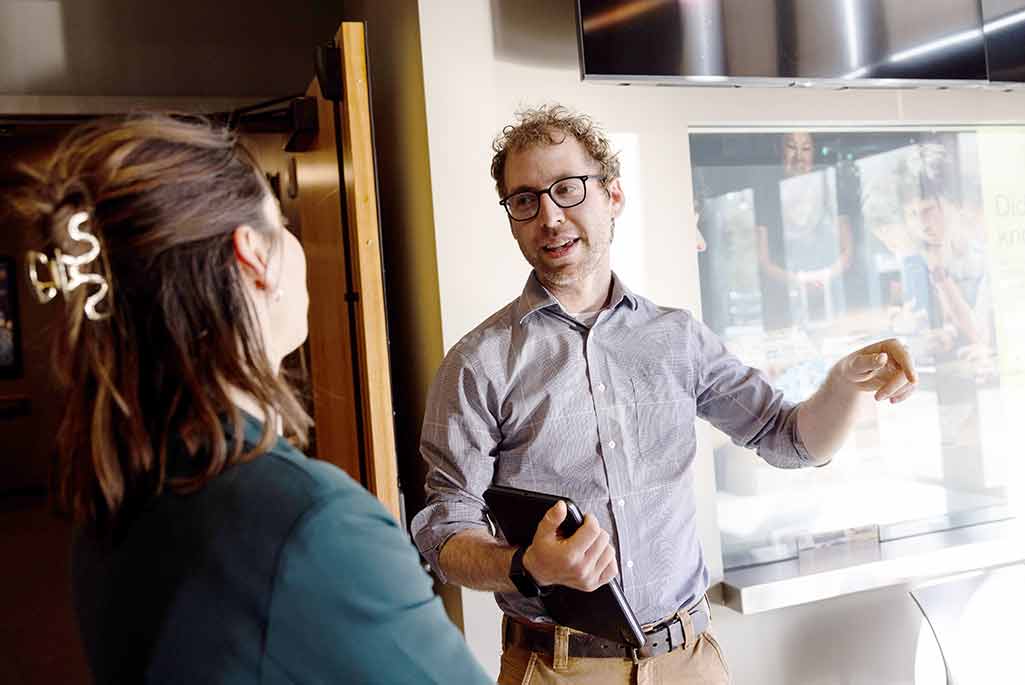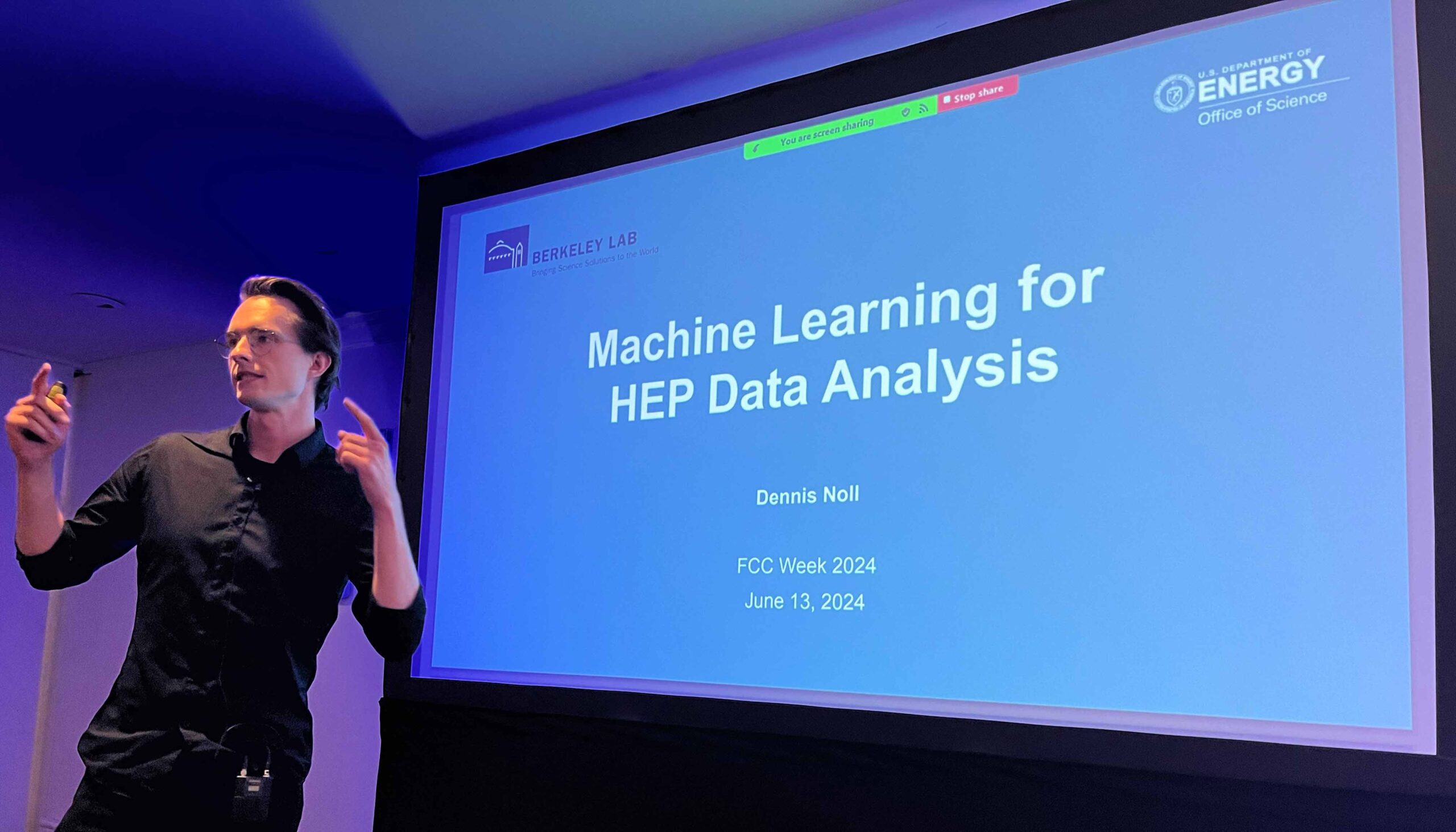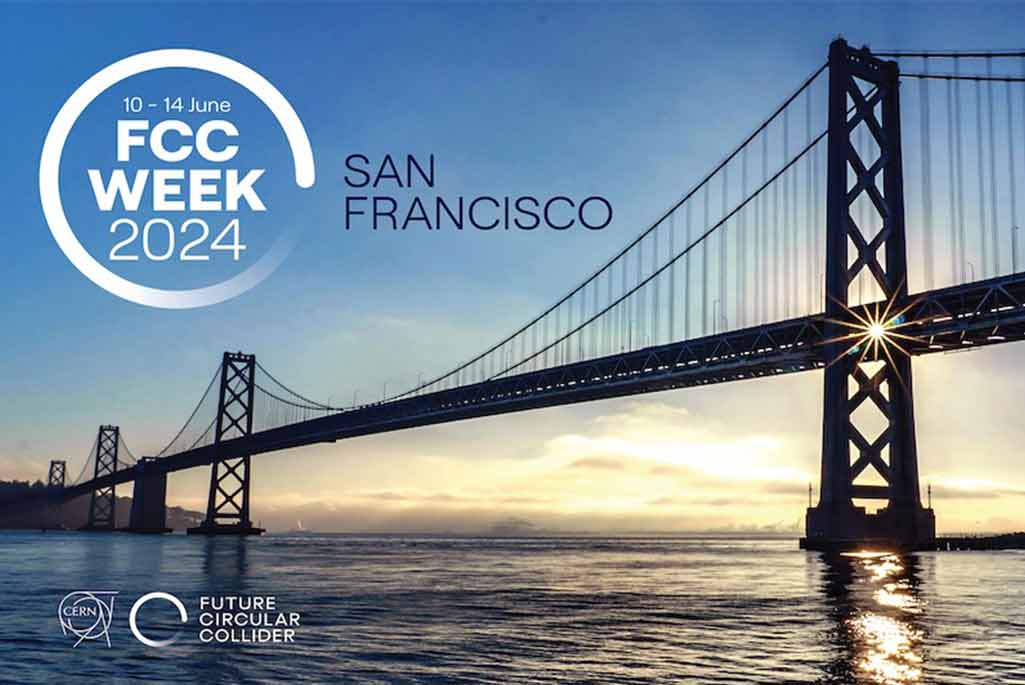Berkeley Lab scientists and engineers served on the local organizing committee and presented talks for the tenth edition of the Future Circular Collider (FCC) Conference, hosted by the European Organization for Nuclear Research (CERN) in San Francisco on June 10-14, 2024.
The event convened over 400 international scientists, with expertise spanning a diverse array of research domains, working together to advance the feasibility study for a visionary post-LHC research infrastructure at CERN. Presentations, breakouts, and poster sessions focused on research site infrastructure, accelerator design and operations, detector design, physics sensitivity, and cross-cutting considerations such as AI/ML and early career researcher participation.
 “The FCC is an extraordinary ring-based particle collider being proposed for construction at CERN,” explains Soren Prestemon, the ATAP Division’s Deputy for Technology and the Director of the US Magnet Development Program, who served as co-chair of the event’s Local Organizing Committee. “It would initially serve as a unique ‘Higgs factory,’ producing a large number of Higgs bosons that would enable detailed studies of the particle’s properties.” Identified as one of the key recommendations in the 2023 P5 Report, there is a broad consensus in the global particle physics community that understanding the nature of the Higgs boson is among the highest scientific priorities of the field, and that a Higgs factory should be the next high-energy accelerator facility. (Photo above right: Prestemon (center) talks with Zoltan Ligeti (on left with blue shirt), Chris Reis (at far right, an ATAP research assistant and currently a Ph.D. student in UC Berkeley’s Nuclear Engineering Department), and other guests at the public event on June 11. Credit: Drew Bird).
“The FCC is an extraordinary ring-based particle collider being proposed for construction at CERN,” explains Soren Prestemon, the ATAP Division’s Deputy for Technology and the Director of the US Magnet Development Program, who served as co-chair of the event’s Local Organizing Committee. “It would initially serve as a unique ‘Higgs factory,’ producing a large number of Higgs bosons that would enable detailed studies of the particle’s properties.” Identified as one of the key recommendations in the 2023 P5 Report, there is a broad consensus in the global particle physics community that understanding the nature of the Higgs boson is among the highest scientific priorities of the field, and that a Higgs factory should be the next high-energy accelerator facility. (Photo above right: Prestemon (center) talks with Zoltan Ligeti (on left with blue shirt), Chris Reis (at far right, an ATAP research assistant and currently a Ph.D. student in UC Berkeley’s Nuclear Engineering Department), and other guests at the public event on June 11. Credit: Drew Bird).
 Ben Nachman, a staff scientist and head of the Physics Division’s Machine Learning Group, also served on the Local Organizing Committee and organized a mini-workshop on AI/ML. “I especially enjoyed the AI/ML session that spanned the entire workflow including facilities design and operations, experimental design, data acquisition, and finally, data analysis,” said Nachman. “It is clear that the future of the energy frontier will be super-charged by AI/ML.” (Photo above left: Nachman talks with Julia Gonski, a staff scientist at SLAC and co-chair, with Soren Prestemon, of the event’s Local Organizing Committee. Credit: Drew Bird).
Ben Nachman, a staff scientist and head of the Physics Division’s Machine Learning Group, also served on the Local Organizing Committee and organized a mini-workshop on AI/ML. “I especially enjoyed the AI/ML session that spanned the entire workflow including facilities design and operations, experimental design, data acquisition, and finally, data analysis,” said Nachman. “It is clear that the future of the energy frontier will be super-charged by AI/ML.” (Photo above left: Nachman talks with Julia Gonski, a staff scientist at SLAC and co-chair, with Soren Prestemon, of the event’s Local Organizing Committee. Credit: Drew Bird).
 Berkeley Lab scientists and engineers have made significant contributions to FCC Week conferences since their inception in 2015. This year, in addition to Prestemon and Nachman contributions, Berkeley Lab Director Mike Witherell provided welcome remarks in the event’s opening plenary session. Cameron Geddes (director of the ATAP Division) and Carl Haber (a senior scientist in the Physics Division) served on the Scientific Program Committee, and many other Berkeley Lab staff members gave presentations throughout the conference, including Eric Anderssen (a mechanical engineering group lead in the Engineering Division), Nicole Apadula (a research scientist in the Nuclear Science Division’s Relativistic Nuclear Collisions Program), Paolo Ferracin (a senior scientist and deputy of ATAP’s Superconducting Magnet Program), Arianna Formenti (a postdoc in ATAP’s Advanced Modeling Program), Nishank Nilesh Gite (a student intern in the Physics Division’s ATLAS Group), Remi Lehe (a physicist in ATAP’s Advanced Modeling Program), Zoltan Ligeti (senior physicist in the Physics Division’s Theory Group), Dennis Noll (a postdoc in the Physics Division’s ATLAS Group), Vakho Tsulaia (a software developer in the Physics Division’s ATLAS Group), Jean-Luc Vay (a senior scientist and head of the ATAP’s Advanced Modeling Program), Zhenyu Ye (a divisional fellow in the Nuclear Science Division’s Relativistic Nuclear Collisions Program). (Photo above/right: Dennis Noll presents a talk on Machine Learning for HEP Data Analysis, Credit: Ben Nachman.) The full list of presentations can be found in the event agenda.
Berkeley Lab scientists and engineers have made significant contributions to FCC Week conferences since their inception in 2015. This year, in addition to Prestemon and Nachman contributions, Berkeley Lab Director Mike Witherell provided welcome remarks in the event’s opening plenary session. Cameron Geddes (director of the ATAP Division) and Carl Haber (a senior scientist in the Physics Division) served on the Scientific Program Committee, and many other Berkeley Lab staff members gave presentations throughout the conference, including Eric Anderssen (a mechanical engineering group lead in the Engineering Division), Nicole Apadula (a research scientist in the Nuclear Science Division’s Relativistic Nuclear Collisions Program), Paolo Ferracin (a senior scientist and deputy of ATAP’s Superconducting Magnet Program), Arianna Formenti (a postdoc in ATAP’s Advanced Modeling Program), Nishank Nilesh Gite (a student intern in the Physics Division’s ATLAS Group), Remi Lehe (a physicist in ATAP’s Advanced Modeling Program), Zoltan Ligeti (senior physicist in the Physics Division’s Theory Group), Dennis Noll (a postdoc in the Physics Division’s ATLAS Group), Vakho Tsulaia (a software developer in the Physics Division’s ATLAS Group), Jean-Luc Vay (a senior scientist and head of the ATAP’s Advanced Modeling Program), Zhenyu Ye (a divisional fellow in the Nuclear Science Division’s Relativistic Nuclear Collisions Program). (Photo above/right: Dennis Noll presents a talk on Machine Learning for HEP Data Analysis, Credit: Ben Nachman.) The full list of presentations can be found in the event agenda.
As part of the larger program, a free public special public event – What’s Left to Discover? Our Unknown Universe – was presented at San Francisco’s Exploratorium on June 11. In the first part of the program, Daniel Whiteson, a professor of physics at UC Irvine, spoke about current research efforts to answer some of the open questions about the nature of the universe:
The second part of the evening featured a discussion with Hitoshi Murayama, a professor of physics at UC Berkeley and a senior physicist in Berkeley Lab’s Physics Division who served as chair of the 2023 P5 Committee, and Fabiola Gianotti, Director-General of CERN, moderated by KQED science and climate reporter Danielle Venton, on the latest breakthroughs in particle physics and their implications for our understanding of matter and energy, among other topics:
Collaboratively organized with the European Union’s Horizon 2020 program for the Future Circular Collider Innovation Study (FCCIS), the conference was jointly co-organized by Argonne National Laboratory, Berkeley Lab, Brookhaven National Laboratory, SLAC National Accelerator Laboratory, Fermilab, Thomas Jefferson National Accelerator Facility, and the US Department of Energy (DOE), with generous support from the University of California’s Berkeley, Davis, Irvine, and Santa Cruz campuses, and California State University East Bay.
